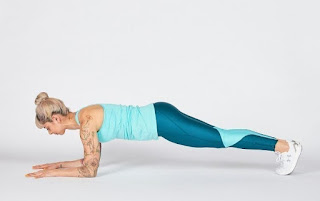Regardless of your age or saw capacity, there are sure activities that have fantastic advantages for each body. These useful quality activities impersonate developments in our day by day lives and help reinforce our center, made up of our stomach divider, back and hips. Building up a solid center helps with appropriate postural arrangement, diminishes weight on your back and knees and makes ordinary exercises less demanding.
To guarantee safe execution, we have furnished varieties of each activity with comparing movements once you have aced a development. Begin with 8 redundancies of each activity, working your way up to 12-15 reps (except if generally expressed).
SQUAT
Muscles worked: quadriceps, hamstrings, gluteals, erector spinae
Why: The squat is a compound development that uses different muscle gatherings to enhance adjust and strength. The activity makes solid, adaptable hips to sit and remain without distress or help and focuses on the gluteal and quadricep muscles to help diminish weight from your back and knees as you stroll up or down stairs.
READ MORE: 8 Kettlebell Exercises for Everyone
Key focuses: Keep your weight in your foot sole areas as you push your hips back, keeping your knees following over your toes and your chest lifted. Push your foot rear areas into the floor to stand tall and finish one rep. Start with unweighted squats, including weight as you advance.
Movement Sequence: Wall, Air, Weights
Rush
Muscles worked: quadriceps, hamstrings, gluteals
Why: Like squats, rushes are compound developments and increment practical quality, adjust and steadiness.
Key focuses: To play out a static rush, keep your spine unbiased as you broaden your left leg specifically behind you. Place the toes of your left leg on the floor as you gradually diminish your knees, bringing down your body toward the floor. Just go as low as you feel good while keeping your pelvis and spine unbiased and shoulders stacked over your hips. Drive upward through your legs to rectify them and finish one rep. Play out all reps with your left leg behind you, and afterward rehash the activity with your correct leg stretched out behind you. Start with unweighted lurches, including weight as you advance.
Movement Sequence: Static, Reverse, Alternate
PUSHUP
Muscles worked: pectoralis real, deltoids, triceps, transversus abs, erector spinae
Why: Pushups create postural help and abdominal area quality to help in your every day life as you push and reach for things.
Key focuses: Start with your knees or toes at hip-width (or somewhat more extensive than hip-width for greater steadiness). Place your hands on the floor somewhat more extensive than your shoulders. Gradually twist your elbows and lower your body toward the floor while keeping up a nonpartisan spine. Push back up to finish one rep, keeping your body in a straight line all through the whole development.
Movement Sequence: Elevated, Knees, Toes
Line
Muscles worked: erector spinae, latissimus dorsi, biceps, deltoids
Why: Rows create postural help and enhance abdominal area quality in your back and shoulders to enable you to perform pulling and conveying developments.
Key focuses: Beginners should begin with the superman work out: Lay down on the floor in an inclined position. Press your glutes to expand and lift your legs off the floor. Gradually lift your shoulders off the floor in a back augmentation, keeping your head and neck loose. Hold this posture quickly and afterward lower to finish one rep. Just expand the arms overhead on the off chance that you need to build the trouble.
When you've aced the superman, advance to the column: Start in a table best position with your hands grasping two dumbbells on the ground underneath your shoulders and knees beneath your hips. Keeping your arms impartial, pull a dumbbell up keeping your arm near your middle, flexing your elbow and broadening your shoulder. Lower dumbbell to the floor and rehash with the contrary arm. Advance from your knees to your toes to expand the trouble and work on center dependability.
Movement Sequence: Superman, Knee Row, Plank Row
Board
Muscles worked: rectus abs, tranversus abs, erector spinae, quads, deltoids, obliques
Why: Planks create postural help and fortify your stomach, shoulder and center muscles. Boards additionally increment security and adjust.
Key focuses: Beginners should begin on your lower arms and knees: Start on your lower arms, with bowed elbows set beneath your shoulders and your knees behind your hips. Keep up a nonpartisan spine and neck while you hold the board position as long as you can. Shoot for no less than 10 seconds.
Movement to hands and toes: Come up onto your hands and toes to build the trouble. Place your feet hip-width separated, or step them somewhat more extensive for greater solidness. Keep up an impartial pelvis, spine and neck.
Movement to lower arms and toes: Come down to your lower arms, with twisted elbows put underneath your shoulders. Keep up an unbiased pelvis, spine and neck.
Movement Sequence: Knees, Hands, Forearms
SINGLE-LEG BALANCE/DEADLIFT
Muscles worked: quadriceps, abductors, adductors, gluteals, hamstrings, transversus abs
Why: Single-leg practices increment postural help, adjust and soundness.
Key focuses: Start standing tall with a nonpartisan spine and pelvis with your shoulders loose and chest open. Force your correct knee up and lift your foot off the floor and adjust to your left side foot. Keep your standing knee delicate and hold for 10 seconds. Switch legs and hold for 10 seconds.
Movement to single-leg deadlift: Start with the single leg adjust above, at that point gradually begin to broaden your correct leg behind you and enable your abdominal area to gradually move forward. Just go as low as your hamstring will permit without bending or flexing through your spine, utilizing your arms for adjust. Gradually come back to a standing position. Keep your legs hip-width separated, hips square and spine impartial. Perform 5 reiterations for each leg.

Comments
Post a Comment